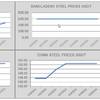It’s a matter of when – not if. Digital is with us, and while many industries have embraced its potential, there is still some reticence in the shipping sector to take the plunge. Norwegian navigation expert Nautisk has rethought its entire product offering to embrace digital, so what have they learned? Nautisk’s head of marketing, John Dawson, explains.
Nautisk has been a specialist chart agent for more than 100 years, and our core product base has been paper charts and printed publications for the shipping sector. But in 2015 we made a major decision – and that was to develop a completely new product range that was digital rather than analogue.
It wasn’t a decision that was taken lightly. Quite the opposite. Norwegians are, at heart, innovators and we could see a future for navigation that was digital. We knew we had to change, so why wait?
For an experienced navigator or ship owner the thought of digital can be uncomfortable. When you have a paper chart and a pen in one hand, there is an element of familiarity; safety. But let’s put this in the same perspective as basic communication. It takes time to write a letter to someone, and there’s an art to it. There’s a process of putting it in the envelope, sealing it, mailing it and then the experience of the recipient at the other end. Once it was how we communicated; it was the only option. But who writes letters now? We send emails, SMS, instant messages, facetime. Nearly everyone we know has a mobile phone or computer, and they receive and respond to messages in seconds.
In the way that basic communication has evolved, digital navigation – in fact, smart ship management – is evolving and those who have adopted the technology early are those that are benefiting from it most. This is necessary to some extent, already, in line with the SOLAS requirements for certain vessels to be fitted with ECDIS.
We have learned plenty from the experience that we think shipping companies can also learn from.
Is digital an expense – or investment?
When we looked at our business model paper was our lifeblood. We made virtually nothing from digital. We took a step change and invested heavily in product development, processes and marketing to make a new – and unique – suite of digital navigation products available to the market. Was it expensive? Of course. And our transition is still happening. But has it been worth it? Of course – because we’re now seeing digital become the dominant source of our revenue, with massive potential still to come.
Our processes are now slick. Our overheads are slim. Our efficiency is greater. Our service is second to none.
We hear time and again that cost is one of the main reasons to delay going digital. But the money we spent on our transition was never seen as an expense. It was an investment in our future.
When you look at a ship’s navigation requirements, you will see shelves full of publications and drawers full of charts – almost certainly thousands of dollars worth per vessel. In truth the value of these assets will have already been written down to a fraction of the purchase cost – a basic accounting transaction. Many of the publications and charts will be out of date or in need of replacing anyway. By going digital you can replace some or all of these items and look at this as business as usual. But behind that decision you’ll be changing process, introducing efficiencies and abolishing redundancy. This is a great example of future-proofing.
Digital is also synonymous with subscription – which means only paying for what you need, when you need it. While our customers can still ‘buy’ paper from us, the majority now benefit from subscriptions across most of our product ranges, so rather than facing a high capital outlay they can pay a manageable monthly cost for what they need.
We’ve even applied this to hardware, so you can choose a full ECDIS solution for a low monthly fee and no capital expense.
What’s the cost of compliance?
There’s a risk element for shipping companies, too, in the form of compliance.
Businesses do need end-to-end thinking when it comes to digital operations. Digital products often come as a suite, and so you can enhance multiple processes through one supplier. This way data sharing provides efficiency and transparency, and evidencing compliance becomes less of an issue. This improves productivity on the bridge. Software and resources are designed to remain up to date and compliant because they are easier to replace or amend.
For example, Nautisk has introduced its NaviTab, which is a tablet that can hold a global library of digital publications as well as file notes and any of the company's standard forms, procedures and documents. It takes up the space of a tablet computer, and not an entire wall of shelves on the bridge. The NaviTab itself tells you when updates are available, so you can make better decisions when it comes to cost and compliance. In effect, Nautisk takes on the risk on behalf of its customers.
Digital products also introduce time savings as well as cost savings. Our NaviPlanner software automates the process of creating a voyage report, so navigation officers can be sure the report is compliant and ready in minutes and then focus on the voyage ahead.
Digital is constantly giving Nautisk opportunities to meet the needs of our customers. So, with NaviPlanner for example, we have a Facebook forum where customers can identify potential issues, tell us about their wishlist or suggest improvements. Because our development process is agile, we now include many of these suggestions in our development ‘sprints’ and roll them out to customers as added value.
We’re about to launch NaviLog, digital log books that offer a better way for ships to manage their operations. This runs on our NaviTab – so customers will not need additional hardware, just a subscription.
The environmental angle
For an environmentally conscious company like Nautisk there is also a green aspect to digital. By removing paper stocks and the freight of paper to vessels we’ve massively reduced our carbon footprint. In 2015 we were handling 35,000 shipments of paper charts and publications every year. This created an air-freight cost for customers on top of the cost of the charts and publications – but also a cost for the planet in terms of fuel and CO2.
Alongside our move from paper to digital navigation services, we still sell paper navigation charts. But again, we’ve evolved how we work. We’ve closed down 45,000 sq ft of warehousing with its associated heat, light and power costs and introduced a more efficient print-on-demand service. We have streamlined our freight services globally, so these paper charts will have fewer airmiles and will still get to a vessel in super-quick time.
The parallels with a vessel are similar. By going digital a vessel will not only introduce more efficient processes, but reduce its own footprint on the planet. You’ll also vicariously benefit from dealing with us, and our own environmental savings.
Change is good
For Nautisk the transformation to digital has been like a reenergizing of the business. Change is often difficult, and can involve tough decisions, expense and upheaval. But the outcomes of change, when it is done well and with the right support, are undeniably positive.
The digital revolution is here. We’re helping our customers through the process, and they’re benefiting from the change. So let’s be clear. This is not change for change’s sake. The transition to digital has to happen, and some companies have already embraced it. If you’re not there yet, at the very least you need to dip a toe in the water today – and then be prepared to take the plunge.
The Author
John Dawson is head of marketing at Nautisk.















